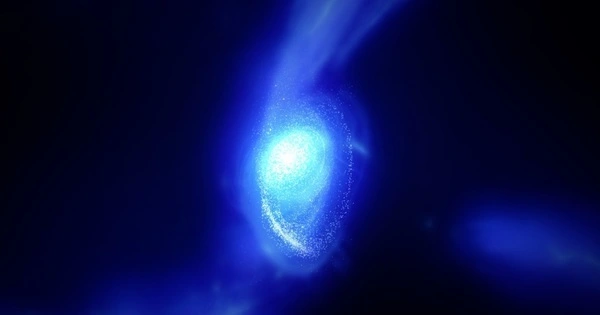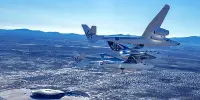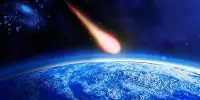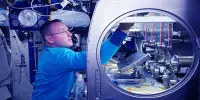The first galaxies appeared after the Big Bang. These galaxies are receding away from us as the universe expands. As a result, their emissions are redshifted (shifted towards longer wavelengths). It is possible to characterize the’motion’ within galaxies as well as their distance by studying these redshifts. Astronomers have discovered a likely rotational motion of one such distant galaxy in a new study.
Astronomers have been able to detect more and more distant galaxies as telescopes have become more advanced and powerful. These are some of the first galaxies to form in our universe, and as the universe expanded, they began to recede away from us. In fact, the greater the distance between us and the galaxy, the faster it appears to move away from us. We can estimate how fast a galaxy is moving, and thus when it formed, by observing how “redshifted” its emission appears. This is similar to the “Doppler effect,” in which moving objects emit light that appears to be shifted towards longer wavelengths (hence the term “redshift”) to the observer.
The Atacama Large Millimeter/submillimeter Array (ALMA) telescope located in the midst of the Atacama Desert in Chile is particularly well-suited for observing such redshifts in galaxy emissions. Recently, a team of international researchers including Professor Akio Inoue and graduate student Tsuyoshi Tokuoka from Waseda University, Japan, Dr. Takuya Hashimoto at University of Tsukuba, Japan, Professor Richard S. Ellis at University College London, and Dr. Nicolas Laporte, a research fellow at the University of Cambridge, UK, has observed redshifted emissions of a distant galaxy, MACS1149-JD1 (hereafter JD1), which has led them to some interesting conclusions.
The rotation speed of JD1 is much slower than that of later epoch galaxies and our Galaxy, and it is likely that JD1 is in the early stages of developing a rotational motion.
Professor Akio Inoue
“Beyond finding high-redshift, namely very distant, galaxies, studying their internal motion of gas and stars provides motivation for understanding the process of galaxy formation in the earliest possible universe,” explains Ellis. The findings of their study have been published in The Astrophysical Journal Letters.
The formation of a galaxy begins with the accumulation of gas and continues with the formation of stars from that gas. Star formation progresses from the center outward over time, forming a galactic disk and giving the galaxy its distinctive shape. Newer stars form in the rotating disk as star formation continues, while older stars remain in the center. The stage of evolution of the galaxy can be determined by studying the age of stellar objects and the motion of stars and gas in the galaxy.
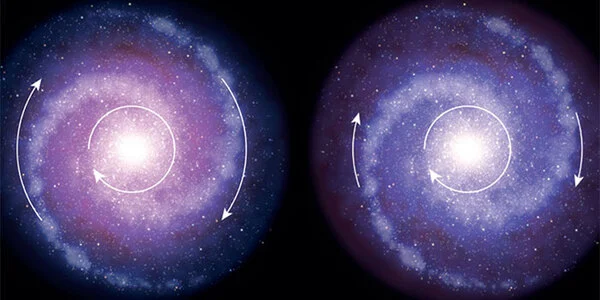
Over the course of two months, the astronomers successfully measured small differences in “redshift” from position to position within the galaxy and discovered that JD1 met the criterion for a galaxy dominated by rotation. They then modeled the galaxy as a rotating disk and discovered that it reproduced the observations very well. The calculated rotational speed was about 50 kilometers per second, which was compared to the rotational speed of the Milky Way disk, which was 220 kilometers per second. JD1 has a diameter of only 3,000 light-years, which is much smaller than the Milky Way’s diameter of 100,000 light-years.
The significance of their discovery is that JD1 is by far the most distant and thus earliest source with a rotating disk of gas and stars discovered to date. Together with measurements from nearby systems in the research literature, the team was able to trace the gradual evolution of rotating galaxies over more than 95 percent of our cosmic history.
Furthermore, the mass estimated from the galaxy’s rotational speed was consistent with the stellar mass previously estimated from the galaxy’s spectral signature, and was primarily derived from “mature” stars that formed around 300 million years ago. “This demonstrates that the stellar population in JD1 formed at an even earlier epoch of the cosmic age,” Hashimoto says.
“The rotation speed of JD1 is much slower than that of later epoch galaxies and our Galaxy, and it is likely that JD1 is in the early stages of developing a rotational motion,” says Inoue. Astronomers plan to use the recently launched James Webb Space Telescope to identify the locations of young and older stars in the galaxy in order to verify and update their scenario of galaxy formation.
